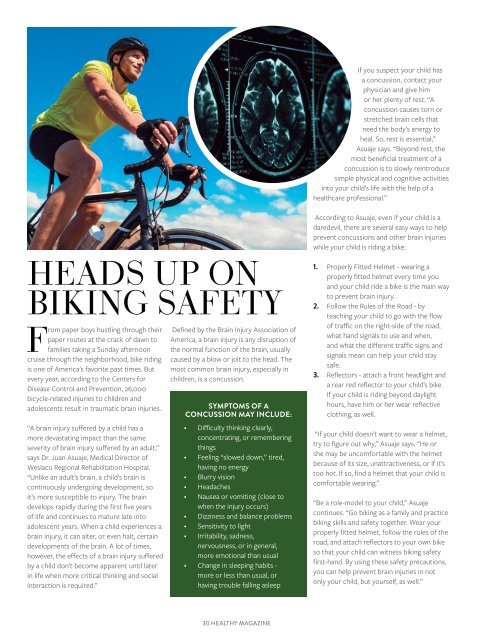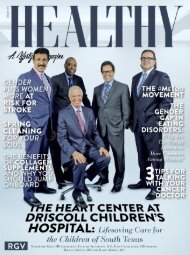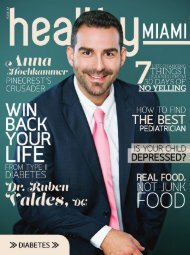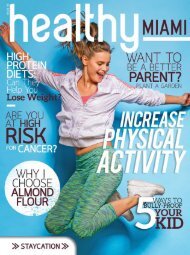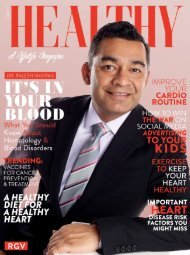Healthy RGV Issue 113
You also want an ePaper? Increase the reach of your titles
YUMPU automatically turns print PDFs into web optimized ePapers that Google loves.
If you suspect your child has<br />
a concussion, contact your<br />
physician and give him<br />
or her plenty of rest. “A<br />
concussion causes torn or<br />
stretched brain cells that<br />
need the body’s energy to<br />
heal. So, rest is essential,”<br />
Asuaje says. “Beyond rest, the<br />
most beneficial treatment of a<br />
concussion is to slowly reintroduce<br />
simple physical and cognitive activities<br />
into your child’s life with the help of a<br />
healthcare professional.”<br />
According to Asuaje, even if your child is a<br />
daredevil, there are several easy ways to help<br />
prevent concussions and other brain injuries<br />
while your child is riding a bike:<br />
HEADS UP ON<br />
BIKING SAFETY<br />
From paper boys hustling through their<br />
paper routes at the crack of dawn to<br />
families taking a Sunday afternoon<br />
cruise through the neighborhood, bike riding<br />
is one of America’s favorite past times. But<br />
every year, according to the Centers for<br />
Disease Control and Prevention, 26,000<br />
bicycle-related injuries to children and<br />
adolescents result in traumatic brain injuries.<br />
“A brain injury suffered by a child has a<br />
more devastating impact than the same<br />
severity of brain injury suffered by an adult,”<br />
says Dr. Juan Asuaje, Medical Director of<br />
Weslaco Regional Rehabilitation Hospital.<br />
“Unlike an adult’s brain, a child’s brain is<br />
continuously undergoing development, so<br />
it’s more susceptible to injury. The brain<br />
develops rapidly during the first five years<br />
of life and continues to mature late into<br />
adolescent years. When a child experiences a<br />
brain injury, it can alter, or even halt, certain<br />
developments of the brain. A lot of times,<br />
however, the effects of a brain injury suffered<br />
by a child don’t become apparent until later<br />
in life when more critical thinking and social<br />
interaction is required.”<br />
Defined by the Brain Injury Association of<br />
America, a brain injury is any disruption of<br />
the normal function of the brain, usually<br />
caused by a blow or jolt to the head. The<br />
most common brain injury, especially in<br />
children, is a concussion.<br />
SYMPTOMS OF A<br />
CONCUSSION MAY INCLUDE:<br />
• Difficulty thinking clearly,<br />
concentrating, or remembering<br />
things<br />
• Feeling “slowed down,” tired,<br />
having no energy<br />
• Blurry vision<br />
• Headaches<br />
• Nausea or vomiting (close to<br />
when the injury occurs)<br />
• Dizziness and balance problems<br />
• Sensitivity to light<br />
• Irritability, sadness,<br />
nervousness, or in general,<br />
more emotional than usual<br />
• Change in sleeping habits -<br />
more or less than usual, or<br />
having trouble falling asleep<br />
1. Properly Fitted Helmet - wearing a<br />
properly fitted helmet every time you<br />
and your child ride a bike is the main way<br />
to prevent brain injury.<br />
2. Follow the Rules of the Road - by<br />
teaching your child to go with the flow<br />
of traffic on the right-side of the road,<br />
what hand signals to use and when,<br />
and what the different traffic signs and<br />
signals mean can help your child stay<br />
safe.<br />
3. Reflectors - attach a front headlight and<br />
a rear red reflector to your child’s bike.<br />
If your child is riding beyond daylight<br />
hours, have him or her wear reflective<br />
clothing, as well.<br />
“If your child doesn’t want to wear a helmet,<br />
try to figure out why,” Asuaje says. “He or<br />
she may be uncomfortable with the helmet<br />
because of its size, unattractiveness, or if it’s<br />
too hot. If so, find a helmet that your child is<br />
comfortable wearing.”<br />
“Be a role-model to your child,” Asuaje<br />
continues. “Go biking as a family and practice<br />
biking skills and safety together. Wear your<br />
properly fitted helmet, follow the rules of the<br />
road, and attach reflectors to your own bike<br />
so that your child can witness biking safety<br />
first-hand. By using these safety precautions,<br />
you can help prevent brain injuries in not<br />
only your child, but yourself, as well.”<br />
30 HEALTHY MAGAZINE


